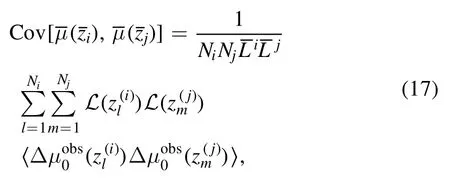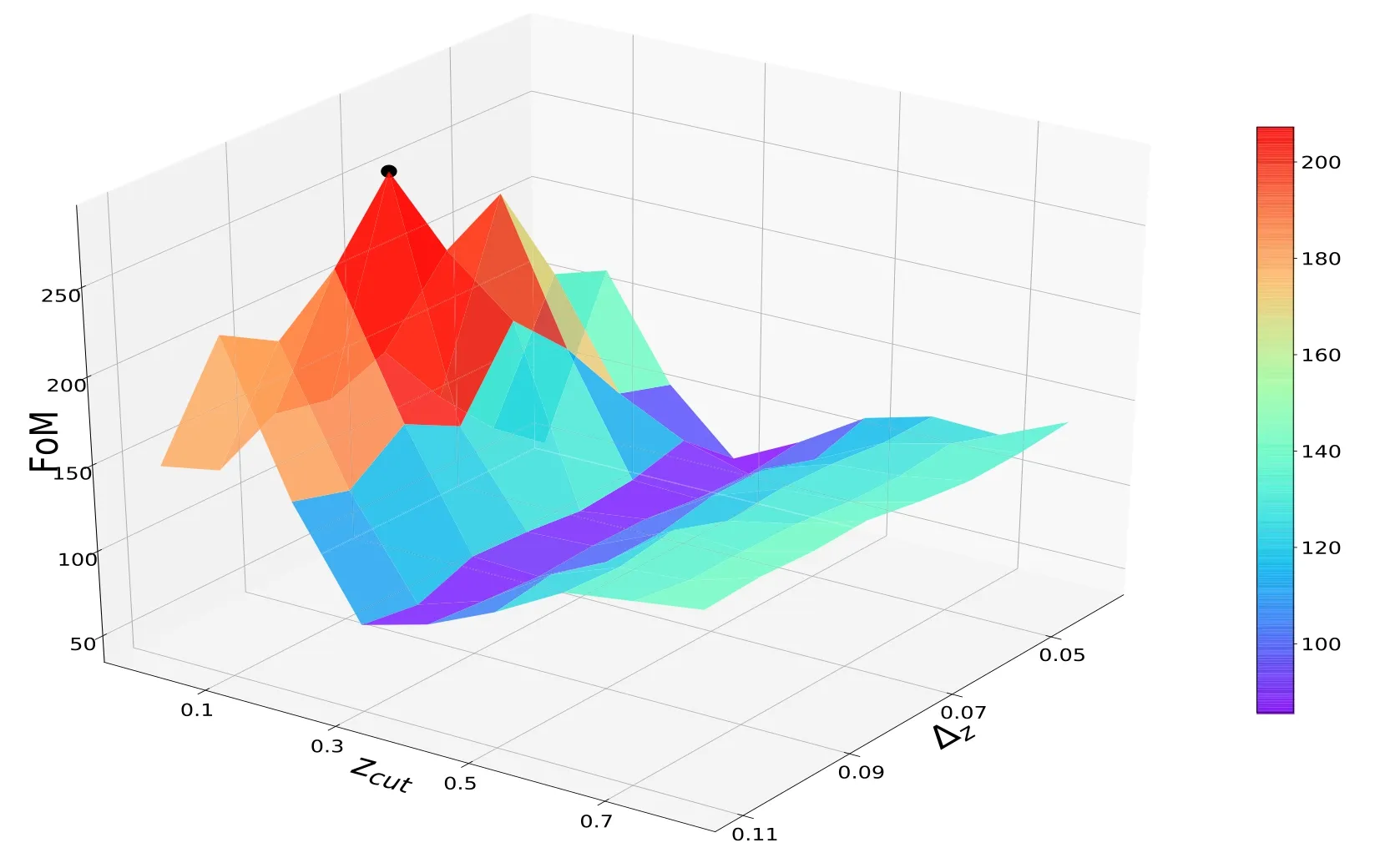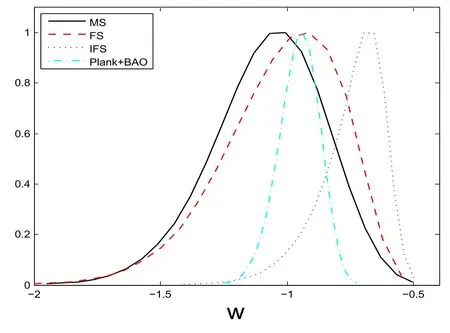Exploring the latest Pantheon SN Ia dataset by using three kinds of statistics techniques
Shuang Wang and Xiaolin Luo
School of Physics and Astronomy,Sun Yat-Sen University,Guangzhou 510297,China
Abstract In this work,we explore the cosmological consequences of the latest Type Ia supernova(SN Ia)dataset,Pantheon,by adopting the wCDM model.The Pantheon dataset currently contains the largest number of SN Ia samples,which contains 1048 supernovae on the redshift range 0 <z <2.3.Here we take into account three kinds of SN Ia statistics techniques,including:(1)magnitude statistics(MS),which is the traditional SN Ia statistics technique;(2)flux statistics(FS),which is based on the flux-averaging (FA) method; and (3) improved flux statistics (IFS),which combines the advantages of MS and FS.It should be mentioned that the IFS technique needs to scan the(zcut,Δz)parameters plane,where zcut and Δz are redshift cut-off and redshift interval of FA,respectively.The results are as follows.(1) Using the SN dataset only,the best FA recipe for IFS is(zcut,Δz)=(0.1,0.08);(2)comparing to the old SN dataset,JLA,adopting the Pantheon dataset can reduce the 2σ error bars of equation of state w by 38%,47%and 53%for MS,FS and IFS,respectively; (3) FS gives closer results to other observations,such as Baryon acoustic oscillations and cosmic microwave background;(4)compared with FS and IFS,MS more favors a Universe that will end in a ‘big rip’.
Keywords: Dark Energy,Type Ia supernova,Cosmological Observations
1.Introduction
The Type Ia supernova (SN Ia),which is a sub-category of cataclysmic variable stars [1],has played a crucial role in discovering the cosmic acceleration [2,3].So far,SN Ia is still one of the most useful and powerful tools to investigate the nature of dark energy (DE) [4–12].
In the recent 10 years,many high-quality supernova dataset have been released,such as ‘Union’ [13],‘Constitution’ [14],‘SDSS’[15],‘Union2’[16],‘SNLS3’[17],‘Union2.1’[18]and‘JLA’ [19].In 2018,the latest ‘Pantheon’ dataset [20],which contains 1048 SN Ia at the redshift range 0 <z <2.3,was released.Using the Pantheon sample,Scolnic et al had given the observational constraints on the wCDM and CPL models [20].
On the other hand,along with the rapid growth of the number of SN Ia discovered,the studies on the systematic uncertainties of SN Ia have drawn more and more attention.It has been proved that [21],the classic SN Ia statistics method(hereafter we will call it ‘magnitude statistic’ (MS)) suffers from various systematic uncertainties,such as the calibration errors [17],the host–galaxy extinction [22–24],the gravitational lensing[25,26],different light-curve fitters[27]and the redshift evolution of SN color-luminosity parameter β[28–34].Therefore,the control of the systematic uncertainties of SN Ia have become one of the biggest challenges in SN cosmology.
In order to reduce the systematic uncertainties of SN Ia,some interesting statistics techniques of SN Ia are proposed in the literature.For examples,in 2000,Wang proposed a new analysis technique,called flux-averaging (FA),to reduce the systematic errors caused by the weak lensing effect of SN Ia[35].The FA technique focus on the observed flux data of SN Ia,and then average these flux data at some redshift bins with same width.Hereafter,we will call this statistics method of SN Ia as ‘flux statistic’ (FS).The FS can reduce several systematic uncertainties of SN Ia [36–38],but it will lead to larger error bars of model parameters.In 2013,One of the present authors and Wang[28]proposed an improved version of flux-averaging.This new statistics method combines the advantages of MS and FS,and thus can reduce the systematic uncertainties and the error bars of model parameters at the same time[39–41].Hereafter,we will call this latest statistics method of SN Ia as ‘improved flux statistics’ (IFS).
In this work,we will explore the Latest Pantheon SN Ia dataset by using all the three statistic techniques of SN Ia (i.e.MS,FS and IFS).It should be emphasized that,in the previous studies about the Pantheon samples[42–45],only MS was taken into account.On the other hand,in our previous studies[39–41],The cosmology fits are always performed by combining SN Ia samples with other observations,such as Cosmic microwave background(CMB) and Baryon acoustic oscillations (BAO).In this work,we will mainly focus on the cosmological constraints given by the Pantheon SN Ia Dataset alone.
The paper is organized as follows.In section.2,we will introduce the methodology used in this work.In particular,we will show how to calculate the χ2function of SN Ia data,for the case of adopting MS,FS,IFS,respectively.In section.3,we will show the results of our studies.We will discuss the differences between cosmological consequences given by Pantheon dataset and by previous SN samples,the differences among the cosmological constraints given by MS,FS,IFS,as well as the ultimate fate of the Universe.Finally,the discussion and conclusion are shown in section.4
2.Methodology
In this section,we introduce how to calculate the χ2function of SN Ia data,for the case of adopting MS,FS,IFS,respectively.
2.1.Magnitude statistics
As shown in[20],adopting MS,the χ2function of SN Ia data can be expressed as

Here the Δμ ≡μobs−μth,where μobsis the observational distance modulus of SN,given by [20]:

where mBis the observed peak magnitude in the rest frame of the B band,M is the absolute B-band magnitude of a fiducial SN Ia,α is the coefficient of the relation between luminosity and stretch,X1describes the time stretching of the light curve,β is the coefficient of the relation between luminosity and color,and C describes the supernova color at maximum brightness.Furthermore,ΔMis a distance correction based on the host-galaxy mass of the SN Ia and ΔBis a distance correction based on predicted biases from simulation.
The theoretically distance modulus of SN Ia μthcan be expressed as

Here zcmbis the CMB rest frame redshift,zhelis the heliocentric redshift and dLis the luminosity distance of SN Ia,given by:

r(z) is given by:

where c is the speed of light,H0is the current value of the Hubble parameter H(z) and E(z)≡H(z)/H0.
For simplicity,in this work we only consider the wCDM model (i.e.DE equation of state (EOF) w is a constant parameter) in a flat Universe.Based on the Friedmann equation,we can get:

where Ωr,Ωmand Ωderepresent the current fractional densities of radiation,matter and dark energy,respectively.The radiation density parameter Ωris given by [46]:

wherezeq=2.5 ×Tcmb=2.7255 K and h is the reduced Hubble constant.In the case of only adopting SN samples,we set the radiation density parameter Ωr=0.
In addition,Cov is the total covariance matrix,which is given by:

where the statistical matrix Dstatonly has the diagonal components,it includes the distance error of each SN Ia as follows:

whereis the photometric error of the SN Ia distance,is the distance uncertainty from the mass step correction,is the uncertainty from the peculiar velocity uncertainty and redshift measurement uncertainty in quadrature,is the uncertainty from stochastic gravitational lensing,is the intrinsic scatter,andis the uncertainty from the distance bias correction.Furthermore,Csysis the systematic covariance for each SN Ia.One can find the more details about the uncertainty matrix Cov in [17].
2.2.Flux statistics
FA divides the whole redshift region into some bins with the same width.The segment points of various bins are zi=Δz·i,where Δz is the width of each bin and i=1,2,3,…,n.
As shown in[35],adopting FS,the χ2function of SN Ia data can be expressed as:

where

The observational flux-averaged distance modulus is calculated by:


where the ‘absolute luminosities’{ L(zcmb)}are

with the ‘fluxs’ distance modulus

On the other hand,the theoretical prediction is given by:


For more details about the FA technique,see [35].
2.3.Improved flux statistics
IFS introduces a new parameter,i.e.redshift cut-off zcut.For the case of z <zcut,the χ2function is calculated by using MS;for the case of z ≥zcut,the χ2function is calculated by using FS.It means that:

Comparing to MS,IFS introduces two new parameters,i.e.redshift cut-off zcutand the width of redshift bin Δz.Here we require that zcut=0.1·i,i=0,1,2,…,8;while Δz=0.01·j,j=4,5,6,…,11.
Based on the JLA samples,[39]scanned the whole (zcut,Δz)plane and found that(zcut,Δz)=(0.6,0.06)will give the tightest DE constrains.But this result was obtained by using combined observational data,which included CMB,BAO and SN Ia.In this work,we mainly focus on the SN Ia data.Therefore,using the Pantheon sample alone,we will scan the parameter space of (zcut,Δz).
It should be mentioned that,compared with the conventional approach,the IFS approach is very helpful to reduce the systematic uncertainties of SN Ia.For example,as shown in [28],adopting the IFS approach can significantly reduce the evolution of SN Ia color-luminosity parameter β.
2.4.Other observational data
In addition to the SN Ia samples,some other cosmological observations,such as CMB [47,48,46] and BAO [49–51],also play important roles in exploring the nature of DE.Therefore,for comparison,we also take CMB and BAO data into account.
In this work,for CMB,we use the distance priors data extracted from Planck 2015[52].For BAO,we adopt the data from BOSS DR12 [53],which provides six data points of H(z) and DA(z) at z=0.38,0.51 and 0.61.For more details about calculating χ2of CMB and BAO,see [40].
3.Cosmology fit results
The cosmology fits of this work are performed by using COSMOMC package[54].Moreover,to access the ability of constraining DE for various SN Ia statistics techniques,we also take into account the quantity figure of merit (FoM)[55,56],which is the inverse of the area enclose by the 2σ confidence level (CL) contour of (w,Ωm),for the wCDM model.Therefore:

where Cov(f1,f2,f3,…) is the covariance matrix of the chosen set of DE parameters.
In this section,first of all,we discuss the best recipe for IFS.Then,we compare the cosmological consequence of the Pantheon dataset with the results of the JLA dataset.Finally,we compare the results of MS,FS and IFS,respectively.
3.1.Searching the best FA recipe for IFS
In this subsection,we scan the(zcut,Δz)plane to find the best FA recipe for IFS.As mentioned above,we require that zcut=0.1·i,i=0,1,2,…,8;while Δz=0.01·j,j=4,5,6,…,11.For each set of (zcut,Δz),we perform Markov chain Monte Carlo analysis by using the wCDM model.Then,we compute the corresponding values of the FoM,which are given by equation (19).
A 3D graph of the values of FoM,given by different sets of (zcut,Δz),is shown in figure 1.It is clear that different values of (zcut,Δz) will give different FoMs.Based on this figure,we find that the best FA recipe of IFS is (zcut,Δz)=(0.1,0.08)with the FoM=278.24(denoted by a black dot).Hereafter,we use this recipe for all IFS techniques.

Figure 1.3D graph of the values of FoM,which are given by different sets of(zcut,Δz),for the wCDM model.The black dot represents the best FA recipe (zcut,Δz)=(0.1,0.08) for IFS,which gives the FoM=278.34.

Figure 2.FoM values given by different zcut,for wCDM.The solid red line represents the results constrained only by SN samples.The blue dashed line represents results constrained by the combined SN+BAO+CMB data.
It should be mentioned that the best fitting results of(zcut,Δz) are quite different from the results of [39],which give(zcut,Δz)=(0.6,0.06).The reason is that the results of [39]are obtained by using the combined SN+BAO+CMB data,while the results of the current paper are obtained by using the SN data only.As a cross check,we also scan the parameter space of (zcut,Δz) by using the combined Pantheon+BAO+CMB data.For this case,the obtained results are very similar to the results of [39].This shows the stability of our method.
From the above figure,one can see that varying zcutwill produce larger influence on the value of FoM than changing Δz.In figure 2,we give the results of FoM given by different zcut.The solid red line denotes the results given by using the SN data alone,while the dashed blue line represents the results given by using the combined SN+CMB+BAO data.For the case of using the SN data alone,the values of FoM rapidly decrease at the region zcut>0.1.For the case of using the combined SN+CMB+BAO data,zcut=0.2 will yield the maximal value of FoM.In other words,using the SN data alone will give a smaller zcut.
3.2.The differences between the cosmological consequences of Pantheon and JLA
In this subsection,we compare the differences between the cosmological consequences of Pantheon and JLA.For complete analysis,all the three statistics techniques,including MS,FS and IFS,are taken into account.
In figure 3,we present the 1D marginalized probability distributions of w,which are produced by the Pantheon and JLA datasets,respectively.One can find that,for the case of using MS technique,the results of w given by the Pantheon and JLA data are quite different.for the case of using FS and IFS,the Pantheon and JLA data will give similar results for w.
More details are shown in table 1.For 1σ CL,comparing to the case of using JLA data,using Pantheon data will decrease the the error bars of EoS w by 45%,43% and 56%,for MS,FS and IFS,respectively.For 2σ CL,compared with the case of using JLA data,using Pantheon data will decrease the the error bars of EoS w by 38%,47% and 53%,for MS,FS and IFS,respectively.In addition,using Pantheon data can also increase the values of FoM by 373%,127% and 153%,for MS,FS and IFS,respectively.These results show that compared with the JLA data,the Pantheon data can provide the much tighter DE constraints.
3.3.The differences between the cosmological consequences of MS,FS and IFS
In this part,we compare the differences among the cosmological consequences of MS,FS and IFS.

Figure 3.1D marginalized probability distributions of w for three SN Ia statistics techniques.The solid black lines denote the result from Pantheon and the dashed red lines represent the result from JLA.For all the statistics techniques,the new dataset,Pantheon,gives tighter constraint on w than that constrained by the JLA dataset.
In figure 4,we present the 1D marginalized probability distributions of w.The solid black,dashed red and dotted blue lines denote the results given by MS,FS and IFS,respectively.As a comparison,we also constrain the wCDM model by adopting the combined CMB+BAO data,which is represented by the dash-dotted cyan line.From this figure,one can see that the IFS can give the tightest constraint among the three SN Ia statistics techniques.In addition,comparing with other SN Ia statistics techniques,FS yields a more similar marginalized probability distribution of w to that given by the CMB+BAO dataset.
In figure 5,we plot the 2σ error bars of w for three SN Ia statistics techniques.The solid black,dashed red and dotted blue lines represent the results of MS,FS and IFS,respectively.One can find that using IFS will yield the tightest constraint on w.Moreover,using FS will give a smallest lower limit of EoS w,which is less than −1.As will be discussed in the next subsection,this will lead to a ‘cosmic doomsday’.
4.Conclusions and discussions
In this work,we investigate the cosmological consequences of the latest SN Ia dataset,Pantheon,by using the wCDM model.As a comparison,we also consider the JLA dataset.Moreover,three kinds of SN Ia statistics techniques,including MS,FS and IFS,are taken into account.In addition,we mainly focus on the cosmological consequences given by using SN data alone.
First,based on the wCDM model,we scan the parameter space of(zcut,Δz)to determine the best recipe for IFS.Then,we compare the difference between the fitting results given by the Pantheon and JLA data.Finally,by using SN Ia samples alone,we compare the differences among the cosmological consequences given by MS,FS and IFS.
Our main results are as follows:
• For IFS,we find the best FA recipe(zcut,Δz)=0.1,0.08),which can give the largest FoM=278.34 (see figure 1).Comparing to the case of adopting the combined SN+CMB+BAO dataset,using SN data alone will yield a smaller value of zcut(see figure 2).
• Comparing to the JLA dataset,the Pantheon dataset can give tighter DE constraints(see figure 3).Specifically,the Pantheon data can decrease the 2σ error bars of w by 38%47% and 53%,for MS,FS and IFS,respectively.In addition,using Pantheon data can also increase the values of FoM by 373%,127%and 153%,for MS,FS and IFS,respectively (see table 1).
• FS gives closer results to other observations,such as BAO and CMB (see figure 4).In addition,among the three SN Ia statistics techniques,IFS yields the tightest constraint on w (see figure 5).
In this paper,we only discuss a specific DE model,i.e.the wCDM,which has a constant EoS w.It is interesting to consider the cases of adopting various dynamics DE models,such as quintessence [59],Chaplygin gas [60],holographic DE [61],agegraphic DE [62],Yang–Mills condensate [63],Chevalliear–Polarski–Linder parameterization [64,65] and binned parameterization [66–68].
In addition,in this study we only compare the cosmological consequences of the SN observation with the CMBand BAO observations.It would be interesting to compare the results of the SN observation with some other cosmological observations,such as weak gravitational lensing [69],abundance of galaxy clusters [70],the Alcock–Paczynski effect[71],direct H0measurement [72] and the cosmic age test[73,74].This will be done in future works.

Table 1.The FoM and CL of w for the JLA and Pantheon datasets.

Figure 4.1D marginalized probability distributions of w produced by the Pantheon dataset.The solid black,dashed red and dotted blue lines denote the results given by MS,FS and IFS,respectively.As a comparison,we also constrain the wCDM model by adopting the combined CMB+BAO data,which is represented by the dash-dotted cyan line.

Figure 5.2σ error bars of EoS w given by three SN Ia statistics techniques.The solid black,dashed red and dotted blue lines denote the results given by MS,FS and IFS,respectively.It’s clear that the IFS yields the tightest constraint on w.
Acknowledgments
SW is supported by the National Natural Science Foundation of China under Grant No.11405024 and the Fundamental Research Funds for the Central Universities under Grant No.16lgpy50.
ORCID iDs
 Communications in Theoretical Physics2021年4期
Communications in Theoretical Physics2021年4期
- Communications in Theoretical Physics的其它文章
- Deposition pattern of drying droplets
- The vacancy defects and oxygen atoms occupation effects on mechanical and electronic properties of Mo5Si3 silicides
- A path integral approach to electronic friction of a nanometer-sized tip scanning a metal surface
- Charged torus-like black holes as heat engines
- Hawking temperature of Kerr anti-de-Sitter black hole affected by Lorentz symmetry violating*
- Pure annihilation decays of and in the PQCD approach
